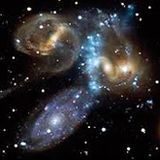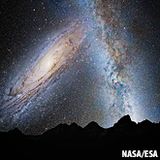
This article written by Mark Wagner for Orion Telescopes & Binoculars explains how to find Andromeda in the sky, what to look for once you've found it, and several amazing facts you will never forget.
I love large galaxies with lots of detail, and the Great Andromeda Galaxy is one of the best. It offers a beautiful elongated glow with a bright, warmly-lit core, dust lanes, and interesting satellite galaxies in its immediate vicinity. The fact that it's hurtling towards our own galaxy at 250,000 miles per hour makes it all the more interesting to return to night after night.
Last week, one of Orion's readers wrote that he's been trying to observe Andromeda for two years. Here I will show you an easy way to find Andromeda. Once you know how to find it, Andromeda will always be an easy-to-locate object full of details to savor.
To star hop to Andromeda you'll be navigating the sky with only your eyes, and then using your telescope pointing skills.
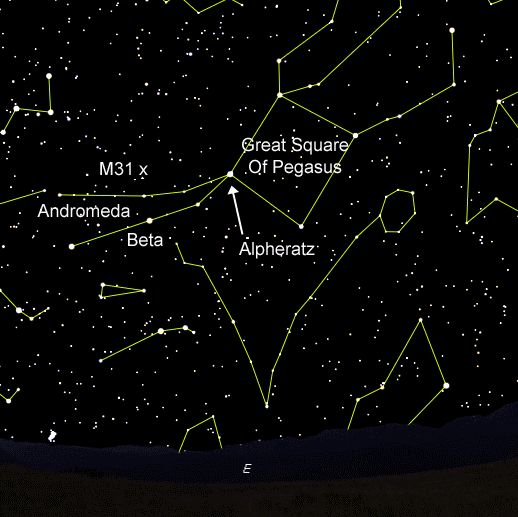
M31
How to find M31:
Just a few hours after sunset this time of year, the sky will be dark, and in the east the landmark constellation Pegasus will be up and easily recognizable. The Great Square of Pegasus is what makes Pegasus a landmark. It's not surprising that we use geometric shapes like a Great Square to find our way around the sky - geometric shapes are the basis for star hopping.
In the image above, you can see the Great Square rising in the east. Its brightest star is Alpheratz. This star is the Alpha (or lucida, meaning brightest) star in Pegasus. Uniquely, it is also the Alpha star in Andromeda, making Alpheratz an Alpha star shared by two constellations. To its left, you can see the constellation Andromeda; two chains of stars extending away from Pegasus. The lower chain contains Beta Andromeda.
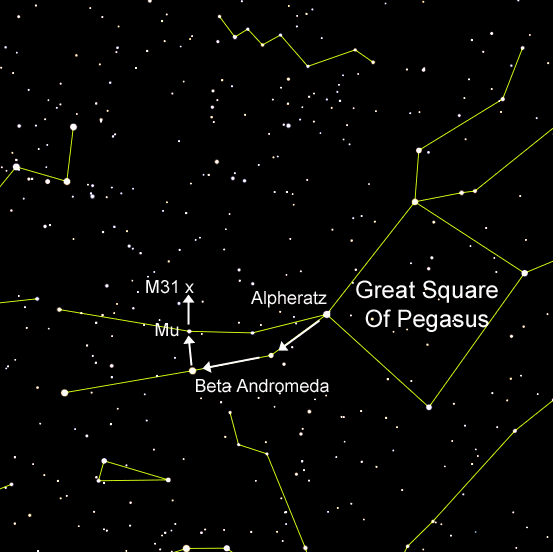
Great Square of Pegasus
So here's our star hop to Andromeda: Use the Great Square to locate Alpheratz. Hop from Aplpheratz to the next star in the lower chain, then hop again one more star along the lower chain to Beta Andromeda. Next, hop in a right angle up to the Mu Andromeda, in the chain of stars above the lower one. Once you're there, move again up and slightly right, a little less than the same distance, and you should see our target in a magnifying finder, or by scanning in widening circles with a low power eyepiece such as a 25 or 32 mm.
You'll know you've found M31 when you see: what appears as an elongated glow, with a brighter central portion. That central glow is the core of the galaxy. M31 is our "sister" galaxy, and one of 30 or so members in The Local Group. Our own galaxy and M31 are easily the largest. M31 is larger than us in size, but recent studies show that our Milky Way is actually more massive.
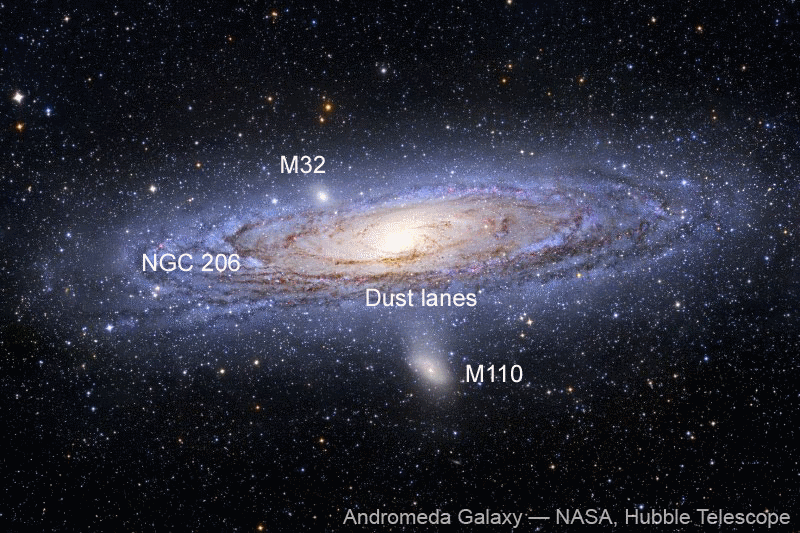
Andromeda Galaxy
Here is a Hubble Space Telescope image of M31.I have added pointers, to show what you can reasonably expect to see in almost any telescope, under good conditions. Just remember, you won't see anything like this Hubble image - you'll see tones of gray on a much smaller scale, although some people do see a warm glow coming from Andromeda. What do you see?
Features to look for in M31:
Note the two dark arcs that define dust lanes in the spiral arms of the galaxy. While you can't see the spiral structure, the dark lanes are obvious. If you have good conditions, you will see a curve on one of the dust lanes, that leads us to two other objects associated with the galaxy.
First is the satellite galaxy M32, a small and compact elliptical galaxy bound to the giant M31. In a small telescope, it will look like an out of focus star. With increased aperture, you will see it as a fuzzy ball.
Near M32, but farther out along the elongation of the spiral arms, is a cluster of blue supergiant stars - these will be a brightening in the arm, catalogued in the New General Catalog as NGC 206 - which is the brightest "star cloud" in M31. Then, back across the galaxy, across its minor axis opposite M32, is M110, a relatively large (but not in comparison to M31!) loose spiral galaxy, which if it were located away from M31 would have a reputation as a great galaxy on its own!
While viewing Andromeda (or any object for that matter), it's always a good idea to revisit a few facts about the object. More often than not, a little food for thought will provide a hair-raising experience as you look through the eyepiece.
Amazing Facts About Andromeda:
Andromeda is over 2 million light years distant. It is the most distant object you can see without optical aid.
At some point in the Milky Way's future, the two galaxies will collide. In fact, Andromeda is moving towards us at 250,000 miles per hour.
The two galaxies will not "crash," they will effectively pass through each other. However, their mutual masses will prove chaotic, with the normal galactic rotations of both galaxies being disrupted, which in turn will cause tremendous new star forming regions to develop.
A great example of such a collision can be seen by searching for images of The Antennae Galaxies in the constellation Corvus. Interested in hunting for the Antennae Galaxies? Stay tuned!
I hope you seek out M31 in your telescope. A mere fifteen minutes spent observing this true spectacle is all you need to fire your imagination, and those of your family and friends. Once you've seen it, you'll come back time and again, making the most of Andromeda and all these wonderful distant details.
Let me know how you do!
Charts created with Starry Night Pro.




